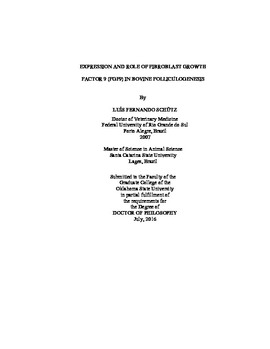| dc.description.abstract | In the ovaries, many members of the FGF family are involved in the regulation of folliculogenesis. One of these members, FGF9, has been characterized as an anti-differentiation factor for its effects on steroidogenesis of granulosa (GC)and theca cells (TC) of cattle, but whether endogenous production of FGF9 changes during follicular development of cattle was unknown. Also, in order to have a comprehensive view of how FGFs regulate folliculogenesis, information of how endogenous production of their receptors (FGFRs) is also required. The first objectives of our studies presented herein was to characterize FGF9, FGFR1c,FGFR2c, FGFR3c, and FGFR4 mRNA abundance in GC and TC during development of dominant follicles in dairy cattle. Estrous cycles of non-lactating dairy cattle were synchronized, and ovaries were collected on either day 3-4 (n = 8) or day 5-6 (n = 8)post-ovulation for GC and TC mRNA extraction from small (1-5 mm), medium (5.1-8mm) or large (8.1-18 mm) follicles for PCR analysis. In GC, FGF9, FGFR1c, FGFR2c, and FGFR3c mRNA abundance was greater (P < 0.05) in estrogen (E2)-inactive (i.e., concentrations of E2 < progesterone, P4) follicles than in large E2-active (i.e., concentrations of E2 > P4) follicles. In TC, FGF9 mRNA abundance was greater (P < 0.05) in large E2-inactive follicles than in large E2-active follicles on day3-4 post-ovulation whereas medium E2-inactive follicles have greater (P < 0.05)FGFR1c and FGFR4 mRNA abundance than large E2-active and E2-inactive follicles on day 5-6 post-ovulation. In addition, FGFR1c, FGFR2c, FGFR3c, andFGFR4 mRNA abundance was greater (P < 0.05) in medium E2-inactive follicles on day 5-6 post-ovulation than on day 3-4 post-ovulation. Following, we aimed to investigate effects of FGF9 on TC through the use of microarray (AffymetrixGeneChip Bovine Genome Arrays) and the bioinformatic tool Ingenuity Pathway Analysis. This software identified differentially expressed transcripts in 346 pathways in response to FGF9 in TC involved in functions such as cell cycle, proliferation, survival, and steroidogenesis. Taken together, these studies reinforce the importance of FGFs in folliculogenesis of cattle. | |
